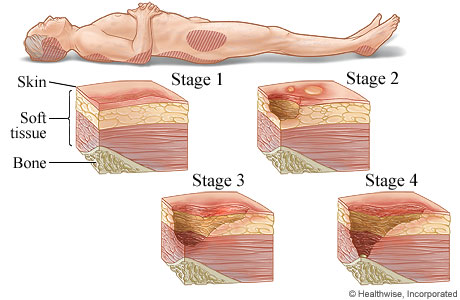Stages of Pressure Injuries

Pressure injuries (bed sores) are an injury to the skin and underlying tissue. They can range from mild reddening of the skin to severe tissue damage-and sometimes infection-that extends into muscle and bone. Pressure injuries are described in four stages:
- Stage 1 sores are not open wounds. The skin may be painful, but it has no breaks or tears. The skin appears reddened and does not blanch (lose color briefly when you press your finger on it and then remove your finger). In a dark-skinned person, the area may appear to be a different color than the surrounding skin, but it may not look red. Skin temperature is often warmer. And the stage 1 sore can feel either firmer or softer than the area around it.
- At stage 2, the skin breaks open, wears away, or forms an ulcer, which is usually tender and painful. The sore expands into deeper layers of the skin. It can look like a scrape (abrasion), blister, or a shallow crater in the skin. Sometimes this stage looks like a blister filled with clear fluid. At this stage, some skin may be damaged beyond repair or may die.
- During stage 3, the sore gets worse and extends into the tissue beneath the skin, forming a small crater. Fat may show in the sore, but not muscle, tendon, or bone.
- At stage 4, the pressure injury is very deep, reaching into muscle and bone and causing extensive damage. Damage to deeper tissues, tendons, and joints may occur.
In stages 3 and 4 there may be little or no pain due to significant tissue damage. Serious complications, such as infection of the bone (osteomyelitis) or blood (sepsis), can occur if pressure injuries progress.
Sometimes a pressure injury does not fit into one of these stages.
- In some cases, a deep pressure injury is suspected but cannot be confirmed. When there isn’t an open wound but the tissues beneath the surface have been damaged, the sore is called a deep tissue injury (DTI). The area of skin may look purple or dark red, or there may be a blood-filled blister. If you or your doctor suspect a pressure injury, the area is treated as though a pressure injury has formed.
- There are also pressure injuries that are “unstageable,” meaning that the stage is not clear. In these cases, the base of the sore is covered by a thick layer of other tissue and pus that may be yellow, gray, green, brown, or black. The doctor cannot see the base of the sore to determine the stage.
Current as of: September 26, 2018
Author: Healthwise Staff
Medical Review:E. Gregory Thompson, MD – Internal Medicine & Adam Husney, MD – Family Medicine & Kathleen Romito, MD – Family Medicine & Margaret M. Doucette, DO – Physical Medicine and Rehabilitation, Wound Care, Hyperbaric Medicine
This information does not replace the advice of a doctor. Healthwise, Incorporated, disclaims any warranty or liability for your use of this information. Your use of this information means that you agree to the Terms of Use. Learn how we develop our content.

